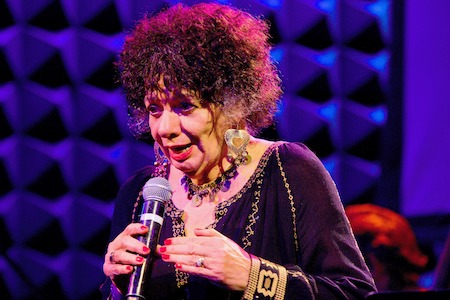Oct 28, 2025 10:47 AM
In Memoriam: Jack DeJohnette, 1942–2025
Jack DeJohnette, a bold and resourceful drummer and NEA Jazz Master who forged a unique vocabulary on the kit over his…

Vocalist Jay Clayton boasts three new albums.
(Photo: R.I. Sutherland-Cohen)Back in the 1960s, when singer Jay Clayton was just in her 20s, she landed a regular jazz gig at Pookie’s Pub, a dive bar on Manhattan’s Lower West Side. In anticipation of a move to Europe — so many of New York’s jazz musicians were moving there then — she’d sublet her unheated loft on Lispenard Street, in Tribeca. But a gig is a gig, so she changed her mind and stayed.
“I played Pookie’s every weekend, and one day [Charles] Mingus walked in,” recalled Clayton, who recently turned 80. “He liked what he heard and told the owners that he’d help put their place on the map. Sure enough, a few weeks later, he played a couple of tunes with me, and of course the place was packed. It was just so far-out to be up on that stage, at 22 or 23, with Mingus.”
Clayton’s career is full of such serendipities. When composer Steve Reich was looking for a jazz singer who could read, a mutual friend recommended Clayton, whose loft happened to be a block away from his. Their subsequent collaboration, captured on his 1971 recording Drumming (John Gibson + Multiples), lasted several years.
It was during those early days of the free improvisation movement in New York that Clayton developed her signature style of spontaneous composition: rangy, syllabic vocals; melodic repetition; and impromptu riffs of poetry and spoken word. Later, she would add looping and other electronic effects to her live performance.
Her inventive approach soon caught the attention of jazz, classical and avant garde composers. She would go on to record more than 40 albums as a leader or guest with musicians as varied as jazz innovator Muhal Richard Abrams, experimental classical composer John Cage and cool jazz icon Lee Konitz.
“At that time, I was interested in anything that the voice could do,” Clayton said. “I didn’t sing words, and I doubled the instruments.”
Clayton was one of the first musicians to present loft concerts in lower Manhattan. In the late 1960s, along with her then-husband, drummer Frank Clayton, she hosted the likes of Sam Rivers, JoAnne Brackeen, Hal Galper, Jeanne Lee and Bob Moses at her roomy Tribeca space.
Since those early days, Clayton’s career as a creative vocal musician has continued unabated. As her reputation grew, she began concertizing and teaching regularly, both overseas and throughout the U.S. In 1995, she forged a relationship with Sunnyside Records, releasing Beautiful Life with pianist Fred Hersch.
In January 2020, Clayton released her ninth Sunnyside CD, Alone Together, a duo set with drummer Jerry Granelli. In this exposed setting, Clayton’s subtly expressive voice demands a close listen, as she immerses herself in the late Granelli’s melodically percussive lines.
Later, in November 2020, she launched 3 For The Road (Meistero Music), a trio album with pianist Fritz Pauer and trombonist Ed Neumeister. This vault recording from 2001 gives a representative sampling of Clayton’s eclectic repertoire, as she segues from melodic disjunction (“Love Is A Place”) to gentle balladeering (“Two For The Road”), to wild extemporizing (“Ba Da Da Dat”) and meditative wordlessness (“Gobblers Nob”).
With little opportunity to promote these albums last year, this fall Clayton decided to embark on a short U.S. tour. Beyond promotion for the albums, these concerts are something of a victory lap for the singer, in celebration of her six decades as a jazz musician. Even during a global pandemic, Clayton finds a way to perform.
“A big philosophy of mine is to follow what you love,” she said. “Just know what you’re going to do next, and that usually leads to another thing. [In the loft days] I was just trying to sing better. It wasn’t like I had anything specific in mind. All of my vocal improvising came out of that.” DB

Jack DeJohnette boasted a musical resume that was as long as it was fearsome.
Oct 28, 2025 10:47 AM
Jack DeJohnette, a bold and resourceful drummer and NEA Jazz Master who forged a unique vocabulary on the kit over his…

Goodwin was one of the most acclaimed, successful and influential jazz musicians of his generation.
Dec 9, 2025 12:28 PM
Gordon Goodwin, an award-winning saxophonist, pianist, bandleader, composer and arranger, died Dec. 8 in Los Angeles.…

Flea has returned to his first instrument — the trumpet — and assembled a dream band of jazz musicians to record a new album.
Dec 2, 2025 2:01 AM
After a nearly five-decade career as one of his generation’s defining rock bassists, Flea has returned to his first…

To see the complete list of nominations for the 2026 Grammy Awards, go to grammy.com.
Nov 11, 2025 12:35 PM
The nominations for the 2026 Grammy Awards are in, with plenty to smile about for the worlds of jazz, blues and beyond.…

Nov 13, 2025 10:00 AM
For results of DownBeat’s 90th Annual Readers Poll, complete with feature articles from our December 2025 issue,…







